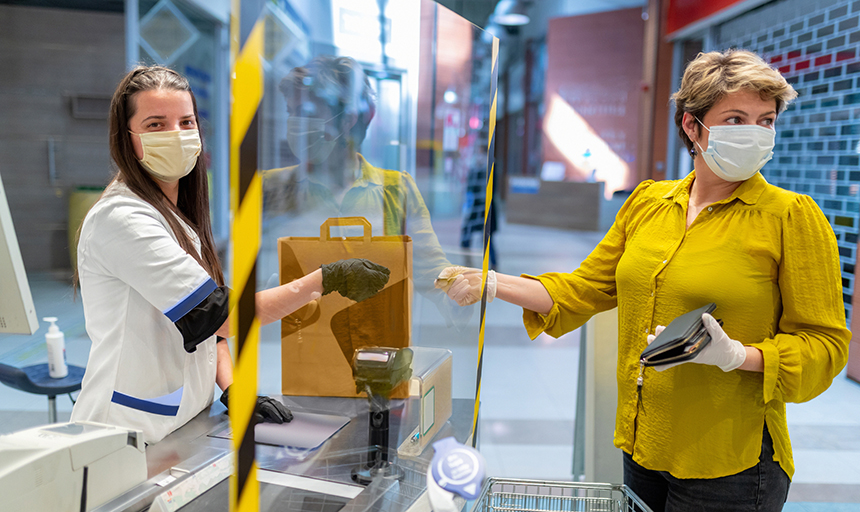Roanoke College Poll: May 2020 Va Consumer Sentiment and Inflation Expectations Report
May 21, 2020

Consumer Sentiment Plummets Amidst Coronavirus Crisis, Positive About the Future
The Virginia Index of Consumer Sentiment plummeted almost 16 points over the last quarter driven primarily by concerns about the current economy. The May 2020 value of 81.5 is the lowest value for the Commonwealth since May 2013 and the contentious gubernatorial primaries before the November McAuliffe and Cuccinelli election. COVID-19 devastated the Virginia economy, pushing initial unemployment claims over 100,000 per week (April) in the Commonwealth. However, Virginians exude confidence about the future of the economy and pulling out of the recession in a speedy manner.
Figure 1. Virginia Consumer Sentiment, past two years

Figure 1 illustrates the hollowing out of the near-record sentiment values from the first quarter of 2020. Twenty-three percent of respondents report that their household finances are improved from a year ago, a twenty-point drop since February. Nationally, the April unemployment rate is 14.7 percent, the highest level seen in decades, sharply rising since March. The layoff and discharge rate increased to 7.5 percent highlighting the current labor market turmoil.
Figure 2. May 2020 Virginia and US Indexes of Current Conditions, Consumer Expectations, and Consumer Sentiment (left to right)

Virginians view of the COVID-effect on the economy differs from the nation as illustrated in Figure 2. Respondents from the Commonwealth are much more concerned about the current economy, particularly businesses. Eighty-nine percent believe that business conditions are worse today than a year ago. Virginians are considerably more optimistic about the economy turning around, with only 29 percent reporting worsening business conditions in the next year. Forty-five percent believe that the next three to five years will be a period of economic growth and prosperity compared to 40 percent who expect a period of high unemployment and stagnation. Figure 3 shows the three consumer sentiment measures over time and the dramatic drop in perceptions of the current economy.
Figure 3. Five-year historical values for three Virginia indexes

Both short- and long-term price expectations continued an upward path, moving above their historical averages. Respondents are sensitive to the prices that they see around them daily. Gas prices fell over 30 percent nationally in April but are currently on the rise. Some food prices are higher due to COVID-related shortages and supply chain issues. Nationally, current inflation remains low, dropping 0.8% in April indicating that the gasoline price decreases outweighed the food price increases over that period.
Figure 4. Short- and long-term inflation expectations


The Virginia Consumer Sentiment and Inflation Expectations Report is sponsored by Atlantic Union Bank.
Analysis
“COVID-19 is taking a toll on the national and Virginia economy,” said Dr. Alice Kassens, senior analyst with IPOR and the John S. Shannon professor of economics at Roanoke College. “The effects are felt by most through the labor market as hours and jobs are cut. Unlike other recessions, the economic fundamentals were strong prior to the COVID-driven recession. Much fiscal stimulus was aimed at keeping people at home rather than encouraging spending. The duration of the recession is largely in the virus’s hands, but once it is contained or a vaccine is available, the economy will rebound at a faster pace than the standard expansionary phase of the business cycle. The labor market should recover within four years rather than a decade or more.”
Methodology
Interviewing for The Virginia Consumer Sentiment and Inflation Expectations Report was conducted by The Institute for Policy and Opinion Research at Roanoke College in Salem, Va. between May 3 and May 16, 2020. A total of 629 Virginians were interviewed. Telephone interviews were conducted in English.
The landline sample consisted of random-digit numbers generated in proportion to the Virginia population so that all residential telephone numbers, including unlisted numbers, had a known chance of inclusion. Cellphone samples were purchased from Marketing Systems Group and Call Delivery Systems. Cellphones comprised 52 percent of the completed interviews.
Questions answered by the entire sample of 629 respondents are subject to a sampling error of plus or minus approximately 4.2 percent at the 95 percent level of confidence. This means that in 95 out of 100 samples like the one used here, the results obtained should be no more than 4.2 percentage points above or below the figure that would be obtained by interviewing all Virginians who have a home telephone or a cellphone. Where the results of subgroups are reported, the sampling error is higher.
Quotas were used to ensure that different regions of the Commonwealth were proportionately represented. The data were statistically weighted for gender, race, and age. Weighting was done to match Virginia census data. The margin of error was not adjusted for design effects due to weighting.
A copy of the questions and all toplines may be found here.
For more about the Institute for Public Opinion Research, click here.
Contact Name: Dr. Alice Louise Kassens, Senior Analyst, IPOR
Contact Phone: (540) 375-2428 Office
Contact Email: kassens@roanoke.edu